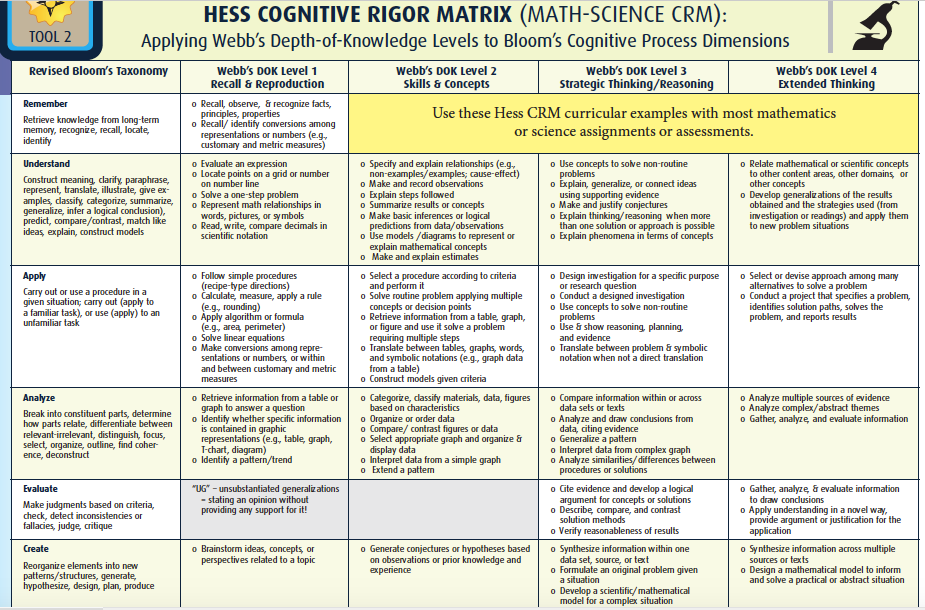One of the things we want to think about as we move forward with both the 5280 view (unit planning) and the ocean view (lesson planning) are the demands that our students face in the classroom.
This week we look at Cognitive Demand (how demanding things are for our students).
How does this connect to our course?
- Series of Lesson Plans (end of class) - Each of the goals you have for your series of lessons should connect to a level of cognitive demand. As the series progresses, there should also be an increase in cognitive demand.
- Lesson Plan - Similarly your objectives should connect to a level of cognitive demand. Are all of your lessons low? Can you have some do some increase? Do they help students get to the point?
Part 1: Cognitive Demands
Cognitive demand refers to the level of mental effort, thinking, and processing required to complete a task or solve a problem. In the context of STEM (Science, Technology, Engineering, and Mathematics), cognitive demand plays a crucial role in understanding and applying concepts.
Here's how cognitive demand connects to STEM:
- Problem Solving and Critical Thinking: STEM subjects often involve complex problems that require analytical thinking. Higher cognitive demand tasks in STEM might require students to analyze data, identify patterns, and devise innovative solutions.
- Application of Knowledge: STEM learning goes beyond rote memorization. It involves applying theoretical concepts to real-world situations. Tasks with high cognitive demand challenge students to adapt their knowledge to novel scenarios.
- Depth of Understanding: STEM subjects are built on layers of knowledge. Higher cognitive demand tasks necessitate a deeper understanding of foundational concepts before progressing to more advanced ones. This ensures a robust grasp of the subject matter.
- Integration of Multiple Disciplines: STEM fields frequently intersect, requiring students to draw on knowledge from various disciplines. Tasks with high cognitive demand often involve synthesizing information from different areas to arrive at a comprehensive solution.
- Experimental Design and Data Analysis: In science and engineering, designing experiments and analyzing data are integral components. These activities involve high cognitive demand as students must plan, execute, and interpret experiments to draw meaningful conclusions.
- Algorithmic Thinking in Technology and Mathematics: In technology and mathematics, tasks with high cognitive demand often involve creating and implementing algorithms. This requires logical reasoning, step-by-step planning, and attention to detail.
- Engineering Design Process: In engineering, students engage in design thinking, which involves iterative problem-solving. This process demands a high level of cognitive engagement as students refine and improve their designs based on testing and feedback.
- Mathematical Modeling: In both science and engineering, mathematical models are used to represent real-world phenomena. Creating and manipulating these models require a deep understanding of mathematical concepts and their application.
- Innovation and Creativity: Higher cognitive demand tasks in STEM encourage creativity and innovation. Students are challenged to think outside the box, explore new approaches, and develop unique solutions to complex problems.
- Metacognition and Reflection: Engaging with tasks that have a high cognitive demand encourages metacognition, which is the ability to think about one's own thinking. Students reflect on their problem-solving processes, identify strengths and weaknesses, and make adjustments for future tasks.
The HESS Cognitive Rigor Matrix.
Below is the Hess Cognitive Rigor Matrix. I think it is a pretty good tool to explore how demanding a task is. To get started I recommend taking a look at a task and thinking about where you think it fits under the Revised Blooms and then follow that row across to see where it fits under Webb's Depth of Knowledge.

Here is a link to the Matrix:
Math & Science CRM
Read here about the History and ‘What’ about the Hess CRM
Part 2: An Activity
Take a look at the following lesson plans (choose one), and explore what you see about how they write about their levels of Cognitive Demand
Math. Science.
Prompt:
1. How would you describe the levels of cognitive demand according to the Math & Science CRM?
2. What do you notice? What do you wonder? (connected to cognitive demand).
3. What do you like? What would you change about the lesson?
